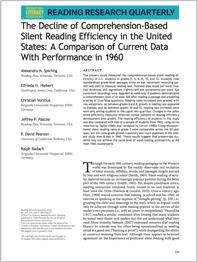
Summary of Findings:
The present study measured the comprehension-based silent reading efficiency of U.S. students in grades 2, 4, 6, 8, 10, and 12. Students read standardized grade-level passages while an eye movement recording system was used to measure reading rate, fixations (eye stops) per word, fixation durations, and regressions (right-to-left eye movements) per word. Eye movement recordings were regarded as valid only if students demonstrated a comprehension level of at least 70% after reading a passage and answering a series of true/false questions. Reading rates increased over grades, with two exceptions: (a) between grades 6 and 8, growth in reading rate appeared to plateau; and (b) between grades 10 and 12, reading rate increases were seen only among students in the upper two quartiles. Changes in the other three efficiency measures reflected similar patterns of reading efficiency development over grades. The reading efficiency of students in this study was also compared with that of a sample of students from 1960, using norms reported by Taylor (1965) and validated by Carver (1989). Comprehension-based silent reading rates in grade 2 were comparable across the 50-year span, but the cross-grade growth trajectory was much shallower in the present study than it was in 1960. These results suggest that present-day students may not achieve the same level of word-reading automaticity as did their 1960 counterparts.
“The present research adds to an ample body of evidence suggesting that the reading proficiency of students in the U.S. is declining. The majority of our high school graduates lack adequate reading proficiency and have little experience with the sorts of challenging text they will face in postsecondary educational settings.”

